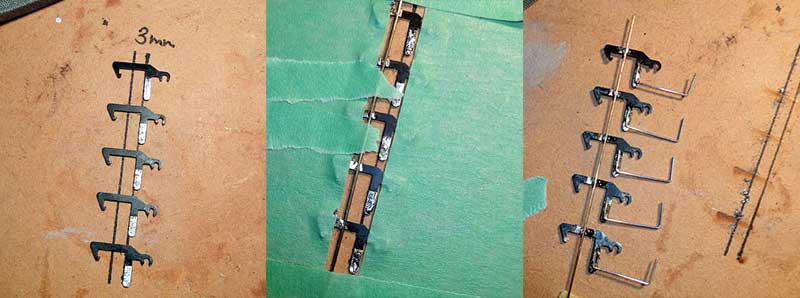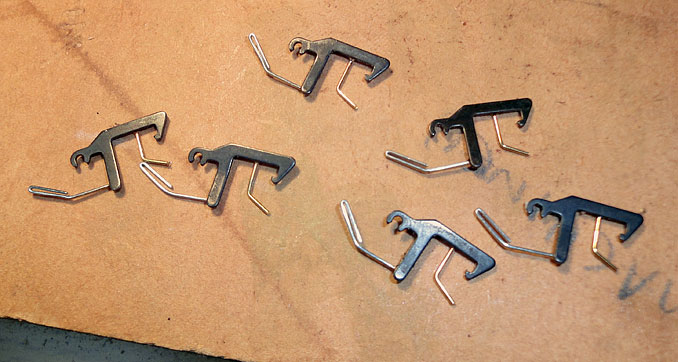I spent the afternoon fiddling with couplings and have a bit more to report then last time. See here for the basic idea and where it came from. I wanted to try the delayed action couplings at both ends of vehicles, i.e. the normal tension lock setup with a hook at both ends, as opposed to Christopher Payne's version which only mounts the hook at one end. Apart from flexiblity, this would mean locos wouldn't have to mount hooks at all, and could just have a neat wire loop and full buffer beam fittings.
I made up a new set of hooks with the magnetic tails and delay latches soldered to the outside, since it seemed likely they would interfere if they were on the insides of the hooks. The critical dimension is that the there should be a 3mm gap between the start of the hook and the delay latch. To speed things up, and since I wanted to do some shunting with a two or three rakes of wagons to give the couplings a proper test, I did a few at a time, with a "jig" consisting of two pen lines and some masking tape - classy!

Removing the completed assembly needed a bit of care, but separating the couplers and trimming/forming the latches was really easy. The latch needs to slip over the other coupling's loop easily, and the end can be trimmed off almost in line with the slope of the hook, it's only there to give space to withdraw the coupling loop after propelling a wagon into position before the hook drops. So they end up fairly small.

I did some hands-on and hands-off testing with an 08 and a mixture of PNAs, Seacows and TEA tanks, to try and cover a range of vehicles with both body and bogie mounts. This is much more of a test than I did last time.
Observations:
- Propelling after uncoupling is pretty robust most of the time, but on curves the latches can sometimes slip off the loops and cause the wagons to recouple. I tweaked them in a little bit which helped.
- Coupling up is reliable, the latches don't seem to hinder this at all.
- Having hooks at both ends helps when coupling heights don't match perfectly - one hook will usually engage even if the other doesn't.
- Some tweaking might be required to balance ease of uncoupling with accidental train breaks.
- The Seacows seemed to need more tweaking than the PNAs and TEAs - maybe because the mounts are quite low and droopy on mine.
- Even with my cack-handed soldering they seem robust enough. I did break a couple of latches, but they were easy to fix. If I was exhibiting with these I'd make up half a dozen extra and just clip a new one in if there were problems.
- Uncoupling requires a bit more care - like Kadees. You have to watch the couplings closely, or listen for the click of the hook lifting. With two hooks you need to be in just the right place. I suspect that with Brian Kirby's larger ceramic magnets this might be easier.
The two biggies:
- If anything goes wrong (involuntary recouple, or a partial couple with one hook latched up and the other down) you can fix it without touching the stock.
- With a bit of practice I was getting about 80-90% success rate shunting rakes of wagons in and out of sidings using only the direction button (and a bit of momentum) on the Powercab. Very satisfying.
Even more than before, I think this is worth pursuing. It would be better with an etched hook, since everything would be happening in the plane of the hook rather than outside it - it seems like it would avoid the recoupling on curves. Plus it'd save my blushes in that I would'nt have to show something I'd touched with an iron to the world at large ![]() I might see if I can draw up some artwork since I have a modelling friend here who sells etched brass kits. Either that or I need some flux and a better jig.
I might see if I can draw up some artwork since I have a modelling friend here who sells etched brass kits. Either that or I need some flux and a better jig.
-
 1
1




0 Comments
Recommended Comments
There are no comments to display.
Create an account or sign in to comment
You need to be a member in order to leave a comment
Create an account
Sign up for a new account in our community. It's easy!
Register a new accountSign in
Already have an account? Sign in here.
Sign In Now